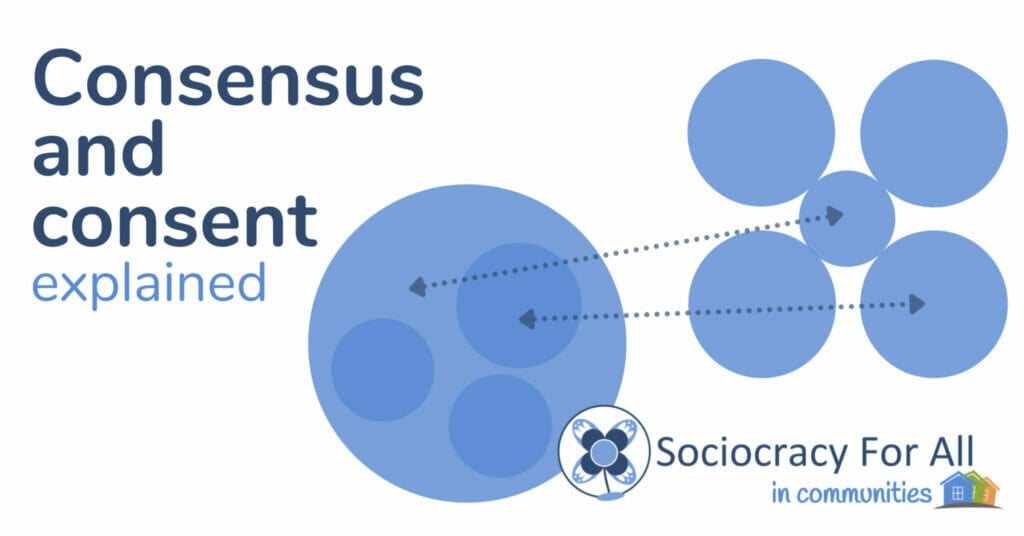
A recurring question in our teaching is to describe the difference between consensus and consent, and between whole-group consensus and Dynamic Governance (sociocracy) used in a community or a cooperative. For simplicity, I will show the difference at the example of a community.
To give people a good image of the situation, let’s picture two communities:
Consensus-run community:
The community holds the value of doing things together. While there might be committees on some aspects of the community, decisions are made together in monthly meetings. In those meetings, everyone comes together and talks. A decision can only move forward when people are on the same page. There is a steering committee of those who prepare those meetings.
Community with Dynamic Governance:
The community has committees (‘circles’) of 4-8 people who meet regularly and focus on a particular aspect of the community, like a Garden Circle, a Finance Circle, etc. Circles will have sub-circles. In the “middle,” there is a General Circle consisting of 2 people from each main circle. The General Circle makes sure every topic has a circle where it can be decided. Decisions themselves are made in circles, not in a whole-community meeting. Decisions are made by consent.
The key difference between the two needs to be separated into two different topics:
- How do we make decisions?
- Who makes decisions?
These topics will now be addressed in the following sections.
1. How do we make decisions: consent vs. consensus
What’s the difference between consensus and consent? The answer to this question highly depends on what is meant by consensus. Let’s start with an oversimplified explanation and then add more context.
- Consensus means a decision is made when everyone agrees.
- Consent means a decision is made when no one objects.
What’s the difference between agreeing and not objecting? There might be proposals that I don’t necessarily agree with but I’m also not against them. For example, let’s say someone proposes to paint the walls in the basement. You might say, well, I would not have agreed with the statement that they have to be painted right now, but I’m also not against it. It’s fine to go ahead.
In consent, one only objects if something harms the project overall or a circle aim, typically in the form of unintended consequences. If there’s no objection, the mantra in consent is “good enough for now, safe enough to try”. The hope is that groups don’t try to convince each other of their favorite idea when they could already make a decision that’s good enough to move on. For example, we might discuss whether the basement really needs new paint when we could also approve it and move on. Granted, if there is harm, someone will object and we’d work together to find a way forward. What would an objection be? For example, if the paint is going to throw off our budget or painting the basement this month would interfere with an event that we have planned.
In this way, consent is very clear. The aim of each circle is defined, and that creates the backdrop of determining whether there will be harm. That’s what is meant by “there is consent if there is no objection”.
On the other hand, consensus is ambiguous how much one has to agree for there to be consensus. In the basement example, it might depend on a lot of factors whether any given individual will say yes or no, and it also depends on the facilitator. If people ask themselves, “do I agree that the basement needs to be painted?” they might be more inclined to block. If they ask themselves, “am I willing to say yes given how much others want the basement to be painted?” then they might say yes. In theory, anyone could say “I don’t like it” and block any proposal without further reasons. Some groups practice consensus in a way that basically is like consent.
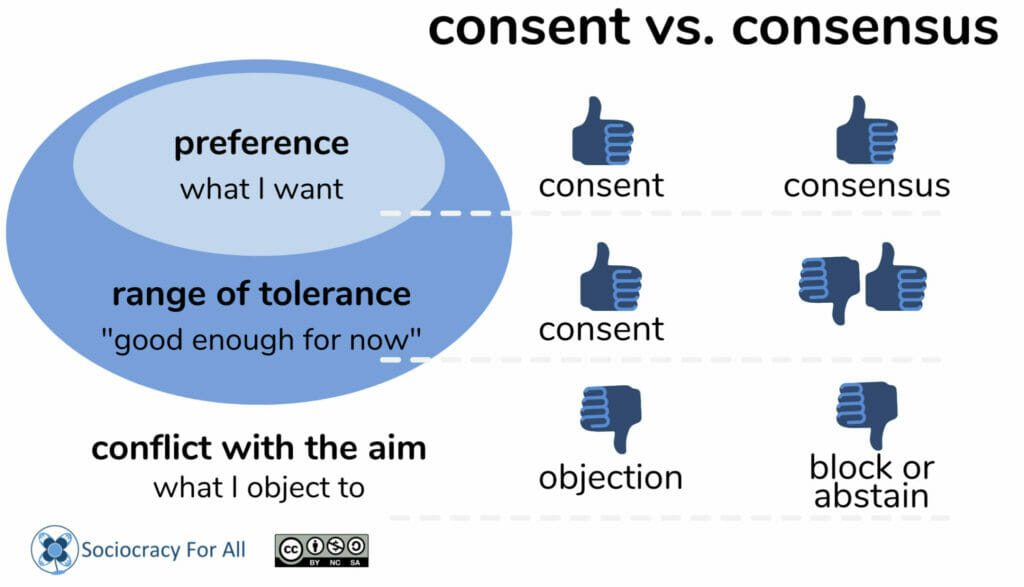
Interested in comparing sociocracy with other forms of decision making? Check out this article comparing Robert’s Rules of Order and sociocracy.
In consensus, it’s not uncommon for people to abstain (stand aside). They might have concerns about the proposal, but they don’t want to be in the way, so they don’t block. (To technically, consensus means a decision is made when everyone agrees or stands aside.)
In consent decision-making, while the bar is a bit higher on what it takes to object (showing how there’s harm), no objection will be ignored, and abstaining is not an option that is allowed. One has to either consent or object. The idea behind that is that if someone hesitates or doesn’t want to be co-responsible, the group should hear the concern – and the process for that is an objection. For that reason, sociocratic groups see objections as something positive, an opportunity to hear more information and align the proposal better with our aim.
| Consent | Consensus | |
| If you agree | consent | consensus |
| If you don’t agree but don’t object | consent | depends* |
| If the proposal has unintended negative consequences | objection | block |
| Abstentions/standing aside | not allowed | allowed |
2. Who makes decisions?
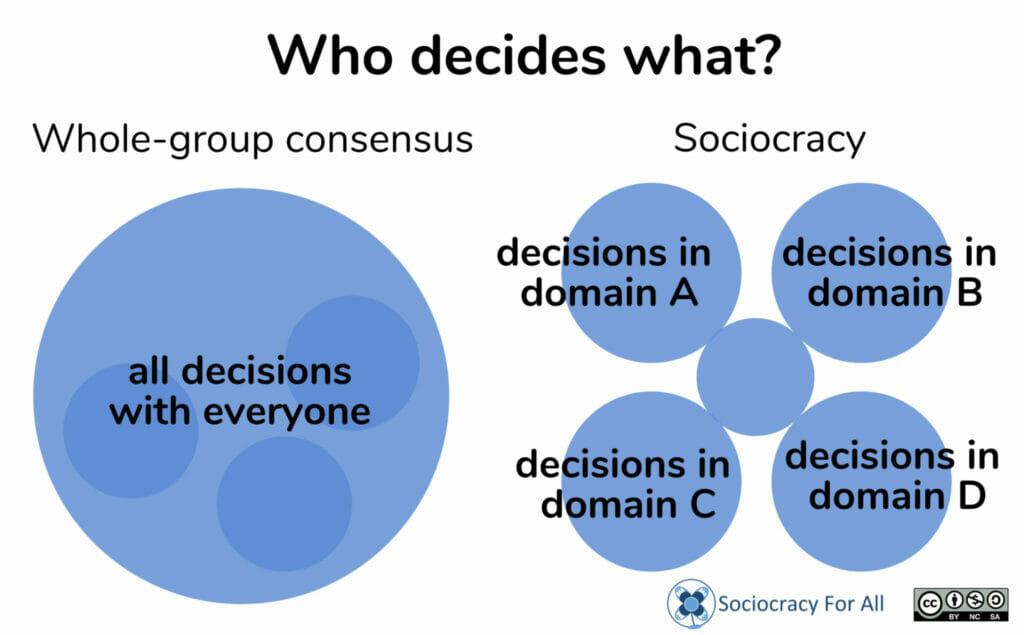
While the difference between consensus and consent might blur in practice, the most significant difference between Dynamic Governance/sociocracy and whole-group consensus is how authority gets distributed.
In whole-group consensus, all (major) decisions are made by everyone together. In sociocracy/DG, decisions are only made in small groups, by circles. Sociocracy uses the term “domain” to describe what a group has authority over. A circle makes decisions about everything that is in its domain. Any decision should fit into a domain so that there’s clarity on what’s decided where.
In whole-group consensus, the all-member group is the decision-making group. While there might be committees that can make minor decisions autonomously, the key decisions require all-member consensus. Committees in whole group consensus often prepare proposals that then need to pass the all-member meeting.
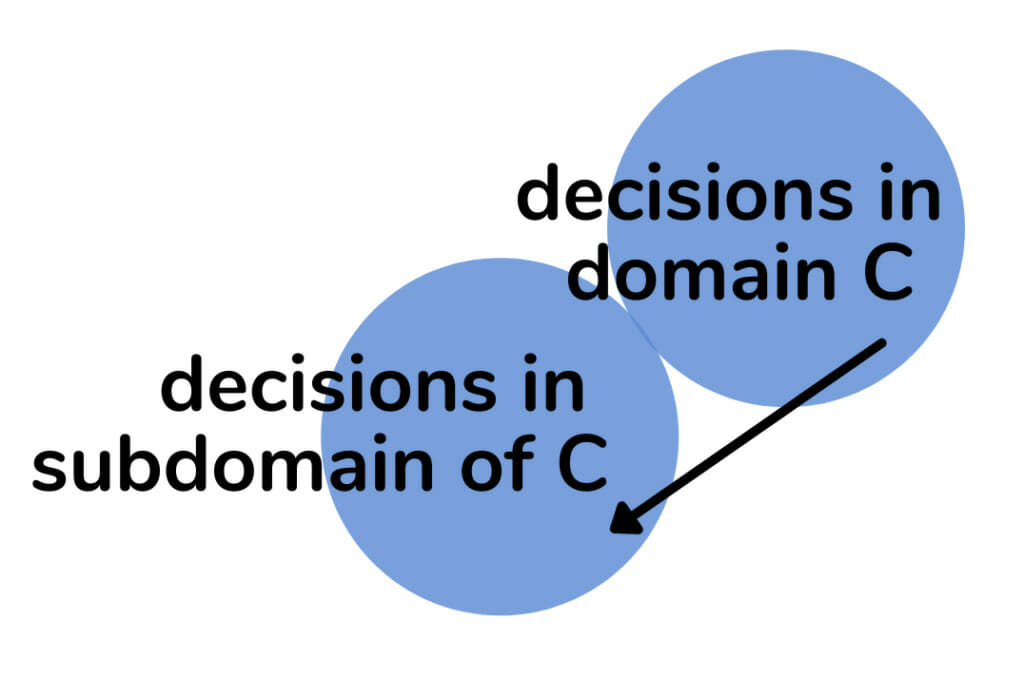
In a sociocratic system, authority is ‘chopped’ into smaller bits, and circles hold those domains. Those who attend those smaller circles are often involved in the operations of that circle, e.g., the gardeners make decisions about the garden, and those tending to the community building will form the Common House Circle that makes decisions about the Common House. Additionally, a circle will form sub-circles and pass part of their domain to that circle. For example, a Common House Circle might pass the authority of making decisions about the kitchen and community meals to a Cooks Circle.
This chunking of authority implies that circles might make decisions autonomously that affect everyone. For example, a Cooks Circle might decide to raise the cost for meals by $0.10 based on their budget experience. This would affect everyone’s meal prices, requiring good communication and trust between circles and community members.
The circle in the middle, the General Circle, supports information flow between the circles and makes decisions about the the domains of the circle. If it’s unclear which circle tends to a question or if there is a shift in domains, the General Circle decides that. Since the General Circle consists of 2 people from each main circle and makes decisions by consent, this will only happen if there’s alignment between all the circles that the change is useful.
Watch to learn more about sociocracy in communities that have previously used consensus? Watch this presentation by SoFA co-founder, Jerry Koch-Gonzalez.
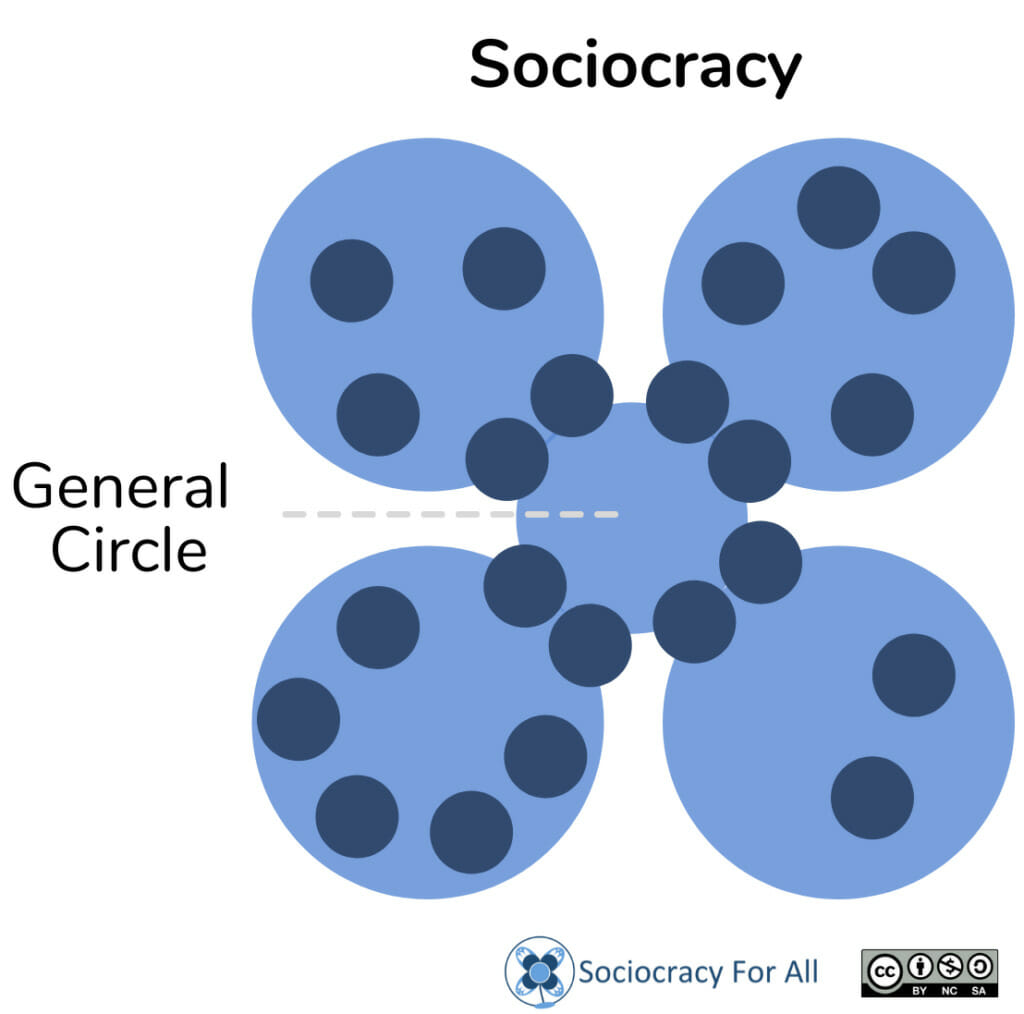
The role of all-member meetings
In whole-group consensus, the General Meeting is the hub for everything. It’s where decisions are made, progress is reported, and people connect with each other.
In communities using sociocracy/Dynamic Governance, an all-member meeting might still be a common practice. Its use is then for connection, reports to all members and feedback to circles on their decisions.
If there are legal requirements (like in a condominium association), the all-member meeting might have to make rare decisions. For example, while the annual budget might be vetted by all circles including the General Circle, it might have to be approved by the all-member meeting to satisfy the external requirements. Once approved, circle might have the freedom to spend their allotted budget as they see fit.
Forming communities
Forming communities of under ten active members might blur the lines between whole-group consensus and Dynamic Governance since the all-member meeting still has the size of a regular circle in Dynamic Governance. The difference then shows over time. In communities using whole-group consensus, additional members join, the all-member meeting grows and still holds all the decision-making power together.
To learn how to turn from one circle into a circle system in sociocracy, see this webinar recording.
Other differences, and hybrid forms
Sociocracy is more than a decision-making system with a circle structure. It also comes with other features, like a meeting format, rounds, selection process, roles in circles, feedback processes and a regular review of policies. Its success heavily depends on how willing the members are to learn the system and use it well. Most of those processes can be used in committees and whole-group consensus as well, but they are geared towards small groups and therefore not as common for larger groups.
In some consensus-run communities, the meeting formats from sociocracy are used for committee meetings but committees don’t have authority to make final decisions in a domain, or might only make minor decisions without all-member approval. Those are hybrid forms; the intention of sociocracy is to fully shift authority into small groups.
To learn more about transitioning from consensus to consent, check out this presentation by Norma Wassel from our global 2021 Sociocracy Conference.
Summary
| Dynamic Governance/sociocracy | Whole-group consensus | |
| Decision-making method | consent | consensus |
| Who decides what | circles decide in their domain | all decisions are made together |
| Circles/committees | Make policy decisions in their domain | Prepare proposals to be approved by the all-member meeting |
| Role of the all-member meeting | Feedback to circles Connection Education (in exceptional cases: decisions) | Decision-making connection |
| Meetings | Following rounds, and sociocratic meeting format | (depends) |
Was this article helpful? Let us know by leaving a comment below.


Leave a Reply
You must be logged in to post a comment.